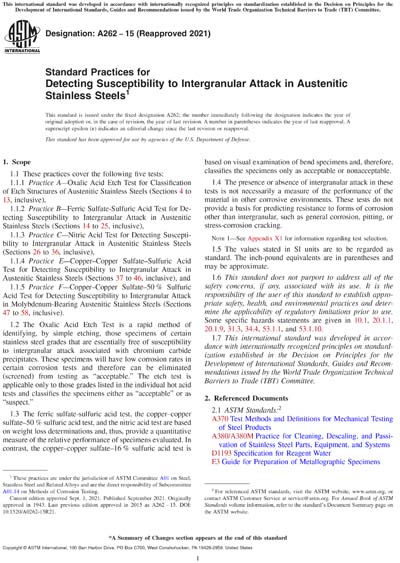Most recent
ASTM A262-15(2021)
Standard Practices for Detecting Susceptibility to Intergranular Attack in Austenitic Stainless Steels
1.1These practices cover the following five tests:
1.1.1Practice A - Oxalic Acid Etch Test for Classification of Etch Structures of Austenitic Stainless Steels (Sections 4 to 13, inclusive),
1.1.2Practice B - Ferric Sulfate-Sulfuric Acid Test for Detecting Susceptibility to Intergranular Attack in Austenitic Stainless Steels (Sections 14 to 25, inclusive),
1.1.3Practice C - Nitric Acid Test for Detecting Susceptibility to Intergranular Attack in Austenitic Stainless Steels (Sections 26 to 36, inclusive),
1.1.4Practice E - Copper"“Copper Sulfate"“Sulfuric Acid Test for Detecting Susceptibility to Intergranular Attack in Austenitic Stainless Steels (Sections 37 to 46, inclusive), and
1.1.5Practice F - Copper"“Copper Sulfate"“50 % Sulfuric Acid Test for Detecting Susceptibility to Intergranular Attack in Molybdenum-Bearing Austenitic Stainless Steels (Sections 47 to 58, inclusive).
1.2The Oxalic Acid Etch Test is a rapid method of identifying, by simple etching, those specimens of certain stainless steel grades that are essentially free of susceptibility to intergranular attack associated with chromium carbide precipitates. These specimens will have low corrosion rates in certain corrosion tests and therefore can be eliminated (screened) from testing as "acceptable." The etch test is applicable only to those grades listed in the individual hot acid tests and classifies the specimens either as "acceptable" or as "suspect."
1.3The ferric sulfate-sulfuric acid test, the copper"“copper sulfate"“50 % sulfuric acid test, and the nitric acid test are based on weight loss determinations and, thus, provide a quantitative measure of the relative performance of specimens evaluated. In contrast, the copper"“copper sulfate"“16 % sulfuric acid test is based on visual examination of bend specimens and, therefore, classifies the specimens only as acceptable or nonacceptable.
1.4The presence or absence of intergranular attack in these tests is not necessarily a measure of the performance of the material in other corrosive environments. These tests do not provide a basis for predicting resistance to forms of corrosion other than intergranular, such as general corrosion, pitting, or stress-corrosion cracking.
Note 1:See Appendix X1 for information regarding test selection.
1.5The values stated in SI units are to be regarded as standard. The inch-pound equivalents are in parentheses and may be approximate.
1.6This standard does not purport to address all of the safety concerns, if any, associated with its use. It is the responsibility of the user of this standard to establish appropriate safety, health, and environmental practices and determine the applicability of regulatory limitations prior to use. Some specific hazards statements are given in 10.1, 20.1.1, 20.1.9, 31.3, 34.4, 53.1.1, and 53.1.10.
1.7This international standard was developed in accordance with internationally recognized principles on standardization established in the Decision on Principles for the Development of International Standards, Guides and Recommendations issued by the World Trade Organization Technical Barriers to Trade (TBT) Committee.
Content Provider
ASTM International [astm]






